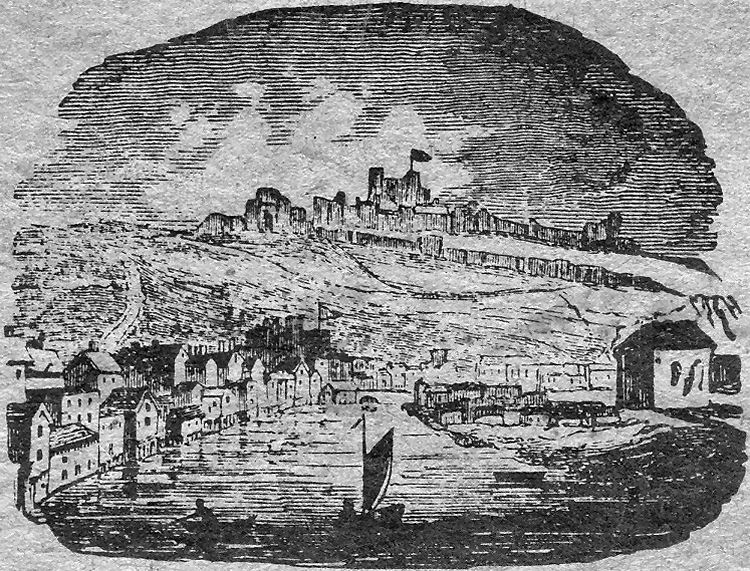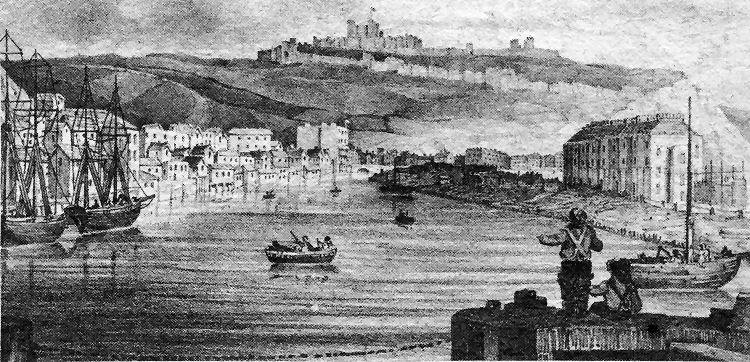Page Updated:- Sunday, 07 March, 2021. |
|||||
 Published in the Dover Express, 13 June, 1980. A PERAMBULATION OF THE TOWN, PORT AND FORTRESS. PART 87.
The next work was the construction of a wall, across from the Long Wall to the back of Snargate Street, to form the Pent. This wall was also made of mud, faggots and piles; and in it were built sluices to operate on the harbour mouth. The sluicing arrangements were not successful; the shingle bar was a lasting trouble, and many expensive devices were adopted, with the hope of getting rid of it. The minutes of the Common Council of January 1676 state that “Freeman reported for wilfully neglecting their watches. A list of defaulters who neglected to come at beat of drum to expel the beach from the harbour mouth. A fine of 1 shilling."
COST OF THE WORK The first enclosure of the Pent, by means of the long and cross walls, only cost the modest sum of £2,700. The work was .not very substantially' done, and before Mr Digges had finished his most western works, the sea made a clean breach in the embankment, along the line of Waterloo Crescent, and to remedy that. Engineer Digges made a very strong work, cross-bound with beams and piles, some of the piles of which were visible outside the present sea wall opposite the old Ordnance Stores. The whole of the work done during the Digges period, which extended from 1581 until shortly before the close of the reign of Elizabeth, cost £7,495; namely—the enclosing of the Pent, £2,700; a lockgate to enclose Little Paradise, £795; the building of a pier, on the line of Strond Street, forming sluices, and erecting floodgates, £2,000; forming the North Pierhead, £1.000; and the timber defences on the Esplanade, £1,000. The twenty years of the Digges period was one of the busiest at Dover Harbour, and, at no time, and under no engineer, was so much done for the money expended.
UNDER THE STUARTS After the death of Queen Elizabeth, activity at Dover Harbour ceased. James 1, in 1606, granted a new charter, which gradually created a new source of revenue, but very little was done, until the reign of Charles II, when about £9,000 was spent, mainly in carrying the north and south piers further out to sea. The whole of the lower part of the harbour, known as Great Paradise, up to that time had been tidal, but then a wall was built across from Clarence Place to Union Street 'now called the Cross-w-all), to form the basin since called the Granville Dock. That work was conducted under the joint superintendence of the Dover Harbour Commissioners and the Master and Wardens of Trinity House.
WILLIAM III. TO VICTORIA Beyond casual repairs, no further work was done till the reign of William III. when sundry improvements were undertaken, including the building of quays, and making of gates in the Crosswall to admit vessels to the basin, which had been previously only used for sluicing purposes. In the early part of the reign of George HI, gates were put in the Union Street wall where Palmerston Bridge used to be. to admit vessels to the upper water; and, at the same time, the Pent was deepened and its area enlarged, so as to obtain a greater volume of water for sluicing. In January, 1808, a storm did great damage to the harbour mouth, and works of repair were undertaken by Mr Moon, the Harbour Master, who also constructed a small dry dock and a small basin on the land now occupied by the Continental goods shed. He also built the reservoir in the South Pier head, with connecting iron culverts to sluice the harbour mouth. All these were works completed before 1820. Another sluicing scheme was carried out in 1832, under the direction of Sir Henry Oxenden.

A fine engraving of the Snargate Street area looking across the old Pent, now the Wellington Dock, towards New Bridge, as seen from the Western Heights. The print was published about 1820 by W. Batchellor, of the King’s Arms Library, at New Bridge. In the foreground a stagecoach hauled by four horses, pauses on its way to the docks.

The picture above is a woodblock engraving of the early 19th century showing the view across the Pent from Union Street quay.

Another view of the Wellington Dock, of the early 1800s, before Northampton Street was formed showing part of Waterloo Crescent on Marine Parade under construction.
|
|||||
|
If anyone should have any a better picture than any on this page, or think I should add one they have, please email me at the following address:-
|
|||||
| LAST PAGE |
|
MENU PAGE |
|
NEXT PAGE | |